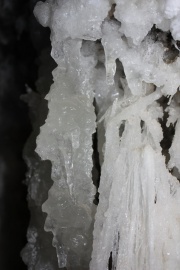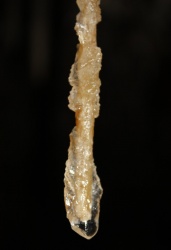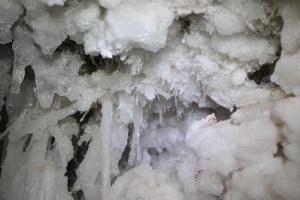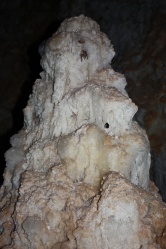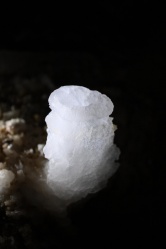Sulfates (Inventory)/Epsomite/Mirabilite
From LagWiki
(Move the gallery) |
|||
| Line 3: | Line 3: | ||
Epsomite is soft and white or clear. It has a bitter taste though it is not appropriate to perform this test in the field. It may appear as needles, stalactites, stalagmites and other dripstone like formations. Mirabilite is clear and usually looks like ice. It has a slightly bitter or salty taste. Both are salts of different metals. Epsomite and mirabilite formations can change seasonally as they are influenced by humidity. They can grow so quickly as to trap and encase hibernating bats. They can also form over other speleothems. These formations are easily confused with similar gypsum formations such as [[Gypsum (Inventory)/Chandelier|Chandeliers]]. | Epsomite is soft and white or clear. It has a bitter taste though it is not appropriate to perform this test in the field. It may appear as needles, stalactites, stalagmites and other dripstone like formations. Mirabilite is clear and usually looks like ice. It has a slightly bitter or salty taste. Both are salts of different metals. Epsomite and mirabilite formations can change seasonally as they are influenced by humidity. They can grow so quickly as to trap and encase hibernating bats. They can also form over other speleothems. These formations are easily confused with similar gypsum formations such as [[Gypsum (Inventory)/Chandelier|Chandeliers]]. | ||
| - | |||
| - | |||
| - | |||
| - | |||
| - | |||
| - | |||
| - | |||
==See also== | ==See also== | ||
| Line 16: | Line 9: | ||
==References== | ==References== | ||
*Palmer, Arthur N. (2007) ''Cave Geology'' CAVE BOOKS, Dayton, OH p 293 ISBN-13: [[Special:Booksources/978-0-939748-66-2|978-0-939748-66-2]], ISBN-10: [[Special:Booksources/0-939748-66-5|0-939748-66-5]] | *Palmer, Arthur N. (2007) ''Cave Geology'' CAVE BOOKS, Dayton, OH p 293 ISBN-13: [[Special:Booksources/978-0-939748-66-2|978-0-939748-66-2]], ISBN-10: [[Special:Booksources/0-939748-66-5|0-939748-66-5]] | ||
| + | |||
| + | ==Epsomite/Mirabilite, Sulfates== | ||
| + | <gallery perrow=2 widths=300px heights=250px> | ||
| + | File:EpsomiteOnASodaStraw.jpg|Epsomite or Mirabilite on a calcite [[Calcite (Inventory)/Stalactite/soda straw|soda straw]] | ||
| + | File:Epsomite 2.jpg|Epsomite | ||
| + | File:Large Epsomite Stalagmite.jpg|Large epsomite stalagmite with trapped bats | ||
| + | File:Small Epsomite Stalagmite.jpg|Small epsomite stalagmite | ||
| + | </gallery> | ||
{{Cave inventory}} | {{Cave inventory}} | ||
Revision as of 01:48, 10 August 2013
The Epsomite/Mirabilite field should be used to list stations where the sulfate minerals epsomite or mirabilite are observed.
Epsomite is soft and white or clear. It has a bitter taste though it is not appropriate to perform this test in the field. It may appear as needles, stalactites, stalagmites and other dripstone like formations. Mirabilite is clear and usually looks like ice. It has a slightly bitter or salty taste. Both are salts of different metals. Epsomite and mirabilite formations can change seasonally as they are influenced by humidity. They can grow so quickly as to trap and encase hibernating bats. They can also form over other speleothems. These formations are easily confused with similar gypsum formations such as Chandeliers.
See also
References
- Palmer, Arthur N. (2007) Cave Geology CAVE BOOKS, Dayton, OH p 293 ISBN-13: 978-0-939748-66-2, ISBN-10: 0-939748-66-5
Epsomite/Mirabilite, Sulfates
Epsomite or Mirabilite on a calcite soda straw |
|
